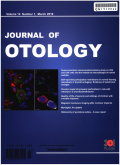- 钛学术文献服务平台 \
- 学术期刊 \
- 医药卫生期刊 \
- 五官科学期刊 \
- 中华耳科学杂志(英文版)期刊 \
Necrotising otitis externa: A single centre experience
Necrotising otitis externa: A single centre experience
基本信息来源于合作网站,原文需代理用户跳转至来源网站获取
摘要:
Introduction: Necrotising otitis externa (NOE) is a rare infection of the ear canal with frequent bone erosion. This study's objective is to describe the different features of NOE as well as its management in an ear-nose-throat department. We also tried to identify the particularities of the fungal infection.Patients and methods: It is an observational cohort that included all the patients hospitalised for the management of NOE. The study was carried out in the ear-nose-throat Department of Mahdia University Hospital in Tunisia between January 2006 and december 2019. Results: A total of 40 patients were included. The mean age was 65 ± 12.9 years and the sex ratio was 0.9. Ninety percent of the patients included were diabetics. The most common signs found were oedema of the external canal (97.5%) and auricular discharge (92.5%). The main pathogen isolated was Pseudomonas aeruginosa (61.7%). Fungi were isolated in 9 cases (26.47%). Computed tomography was performed for 32 patients (80%). Bone erosion was seen in 26 cases (81.3%). The main complications were cerebral venous thrombosis, retropharyngeal abscess and cerebral empyema. Thirty one patients received only antibi-otics, 2 received only antifungal treatment, and 7 received both antibiotics and antifungal treatment. All patients had a favorable outcome. Univariate analysis showed a higher median erythrocyte sedimenta-tion rate was associated with fungal infections. No other differences were noted. Conclusion: Our management protocol seems to be efficient since all patients had initial favorable outcome. A higher median erythrocyte sedimentation rate was associated with fungal infections.

推荐文章
14位Single-slope ADC行为级建模与仿真
单斜模/数转换器
行为级建模
红外焦平面
Simulink
集成电路设计
功能仿真
基于改进的Single-pass算法的新闻热点的发现
新闻热点
话题发现
聚类算法
孤立点预处理和 Single-Pass 聚类结合的微博话题检测方法
微博
热点话题
增量聚类
孤立点
话题检测
内容分析
关键词云
关键词热度
相关文献总数
(/次)
(/年)
文献信息
| 篇名 | Necrotising otitis externa: A single centre experience | ||
| 来源期刊 | 中华耳科学杂志(英文版) | 学科 | |
| 关键词 | |||
| 年,卷(期) | 2021,(1) | 所属期刊栏目 | Research Articles |
| 研究方向 | 页码范围 | 22-26 | |
| 页数 | 5页 | 分类号 | |
| 字数 | 语种 | 英文 | |
| DOI | |||
五维指标
引文网络
引文网络
二级参考文献 (11)
共引文献 (0)
参考文献 (18)
节点文献
引证文献 (0)
同被引文献 (0)
二级引证文献 (0)
1988(1)
- 参考文献(0)
- 二级参考文献(1)
2005(1)
- 参考文献(0)
- 二级参考文献(1)
2007(2)
- 参考文献(0)
- 二级参考文献(2)
2008(1)
- 参考文献(0)
- 二级参考文献(1)
2010(1)
- 参考文献(0)
- 二级参考文献(1)
2012(1)
- 参考文献(1)
- 二级参考文献(0)
2013(3)
- 参考文献(1)
- 二级参考文献(2)
2014(2)
- 参考文献(1)
- 二级参考文献(1)
2015(3)
- 参考文献(1)
- 二级参考文献(2)
2016(2)
- 参考文献(2)
- 二级参考文献(0)
2017(2)
- 参考文献(2)
- 二级参考文献(0)
2018(5)
- 参考文献(5)
- 二级参考文献(0)
2019(5)
- 参考文献(5)
- 二级参考文献(0)
2021(0)
- 参考文献(0)
- 二级参考文献(0)
- 引证文献(0)
- 二级引证文献(0)
引文网络交叉学科
相关学者/机构
期刊影响力
中华耳科学杂志(英文版)
主办单位:
解放军总医院耳鼻咽喉科研究所
出版周期:
季刊
ISSN:
1672-2930
CN:
11-4883/R
开本:
出版地:
北京市复兴路28号
邮发代号:
创刊时间:
语种:
eng
出版文献量(篇)
450
总下载数(次)
0
总被引数(次)
399
期刊文献
相关文献
推荐文献
- 期刊分类
- 期刊(年)
- 期刊(期)
- 期刊推荐

 免费查重
免费查重










